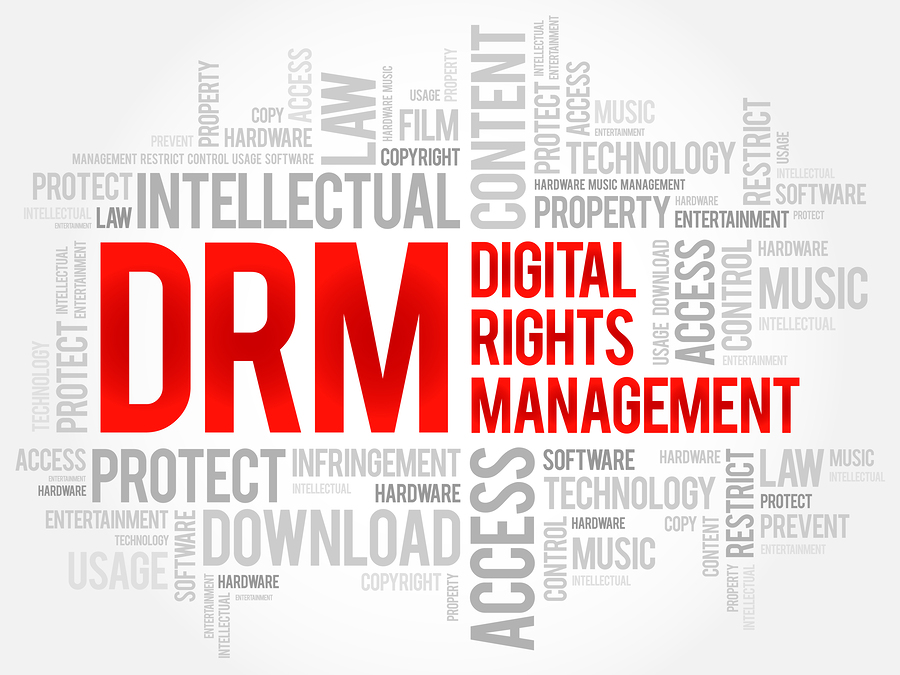Home » Articles posted by E.L. Wisty (Page 2)
Author Archives: E.L. Wisty
Let’s Think About DRM

Wikipedia, Digital rights management, here
Digital rights management (DRM) tools or technological protection measures (TPM)[1] are a set of access controltechnologies for restricting the use of proprietary hardware and copyrighted works.[2] DRM technologies try to control the use, modification, and distribution of copyrighted works (such as software and multimedia content), as well as systems within devices that enforce these policies.[3]
Worldwide, many laws have been created which criminalize the circumvention of DRM, communication about such circumvention, and the creation and distribution of tools used for such circumvention. Such laws are part of the United States’ Digital Millennium Copyright Act,[4] and the European Union‘s Information Society Directive[5] (the French DADVSIis an example of a member state of the European Union (“EU”) implementing the directive).[6]
Common DRM techniques include restrictive licensing agreements: The access to digital materials, copyright and public domain is restricted to consumers as a condition of entering a website or when downloading software.[7] Encryption, scrambling of expressive material and embedding of a tag, which is designed to control access and reproduction of information, including backup copies for personal use.[8] DRM technologies enable content publishers to enforce their own access policies on content, such as restrictions on copying or viewing. These technologies have been criticized for restricting individuals from copying or using the content legally, such as by fair use. DRM is in common use by the entertainment industry (e.g., audio and video publishers).[9] Many online music stores, such as Apple‘s iTunes Store, and e-book publishers and vendors, such as OverDrive, also use DRM, as do cable and satellite service operators, to prevent unauthorized use of content or services. However, Apple dropped DRM from all iTunes music files around 2009.[10]
Parker Higgins, Gizmodo, 12 Dec 2014, It’s Perfectly Legal to Tell People How to Remove DRM, here.
Judge Denise Cote dismissed two publishers’ claims of contributory infringement and inducement inAbbey House Media v. Apple Inc., one of the many cases to come out of the antitrust litigation against Apple and a handful of major publishers.
Abbey House Media operated an ebook store for the publishers Penguin and Simon & Schuster from 2010, and was contractually obligated to wrap the ebooks sold in that store with DRM. When Abbey House shut down the ebook store in 2013, it gave its customers a month’s notice that they would no longer be able to add new devices to read their purchased books on—and also explained that some customers were using the free software package Calibre to remove the DRM so they would be able to move their library to new hardware.
Apprentice Alf’s Blog, 18 Jun 2020, DeDRM Tools 6.8.0 Released, here.
Version 6.8.0 of the tools is now available. Please update to the latest version if you are having issues. To leave a comment, see the previous post: DRM Removal Tools for eBooks.
DeDRM_tools_6.8.0.zip can be downloaded from
https://github.com/apprenticeharper/DeDRM_tools/releases/tag/v6.8.0
Christopher Kelty, aljazeera, 1 Mar 2012, The disappearing virtual library, here.
Last week a website called “library.nu” disappeared. A coalition of international scholarly publishers accused the site of piracy and convinced a judge in Munich to shut it down. Library.nu (formerly Gigapedia) had offered, if the reports are to be believed, between 400,000 and a million digital books for free.
And not just any books – not romance novels or the latest best-sellers – but scholarly books: textbooks, secondary treatises, obscure monographs, biographical analyses, technical manuals, collections of cutting-edge research in engineering, mathematics, biology, social science and humanities.
Lawrence Lessig, Harvard Law School. here.
Code 2.0, here
Lessig’s “Code and Other Laws of Cyberspace” was published in 1999. The book quickly began to define a certain vocabulary for thinking about the regulation of cyberspace. More than any other social space, cyberspace would be controlled or not depending upon the architecture, or “code,” of that space. And that meant regulators, and those seeking to protect cyberspace from at least some forms of regulation, needed to focus not just upon the work of legislators, but also the work of technologists.
Free Culture, here.
“FREE CULTURE goes beyond illuminating the catastrophe to our culture of increasing regulation to show examples of how we can make a different future. These new-style heroes and examples are rooted in the traditions of the founding fathers in ways that seem obvious after reading this book. Recommended reading to those trying to unravel the shrill hype around ‘intellectual property.'”
Edward Felten, Princeton University, here
Felten, et al., v. RIAA, et al., here.
When a team led by Princeton Professor Edward Felten accepted a public challenge by the Secure Digital Music Initiative (SDMI) to break new security systems, they did not give up their First Amendment right to teach others what they learned. Yet they have been threatened by SDMI and the Recording Industry Association of America (RIAA) to keep silent or face litigation under the Digital Millennium Copyright Act (DMCA). Professor Felten has a career teaching people about security, yet the recording industry has censored him for finding weaknesses in their security. USENIX regularly publishes scientific papers that describe the weaknesses of technologies, but they are chilled by RIAA litigation threats.
Richard Stallman, GNU, here.
Defective by Design, FSF, here
Digital Restrictions Management is the practice of imposing technological restrictions that control what users can do with digital media. When a program is designed to prevent you from copying or sharing a song, reading an ebook on another device, or playing a single-player game without an Internet connection, you are being restricted by DRM. In other words, DRM creates a damaged good; it prevents you from doing what would be possible without it. This concentrates control over production and distribution of media, giving DRM peddlers the power to carry out massive digital book burnings and conduct large scale surveillance over people’s media viewing habits.
How I do My Computing, here.
Streaming medias and DRM issues
- Streaming media dis-services such as Netflix and Spotify require nonfree client programs that impose digital restrictions mechanisms (DRM) intended to stop the user from saving a copy of the data being streamed through her own computer. You should never use DRM that you can’t break, so you should not use these dis-services unless you can break their DRM.An additional injustice of these and other streaming client programs is that they impose unjust contracts (EULAs) which restrict the user more strictly than copyright law itself. I do not agree to EULAs, period, and I urge you to join me in rejecting them.These streaming dis-services are malicious technology designed to make people antisocial. (If you don’t have a copy, you can’t share copies.) Rejecting them is of the highest ethical priority.A friend once asked me to watch a video with her that she was going to display on her computer using Netflix. I declined, saying that Netflix was such a threat to freedom that I could not treat it as anything but an enemy.Out, out, damned Spotify! Flick off, Netflix
- Every product with Digital Restrictions Management (DRM) is an attack on your freedom.Therefore, one should not buy or tolerate any product with DRM handcuffs unless one personally possesses the means to break the handcuffs. For instance, don’t use encrypted DVDs unless you have DeCSS or another comparable free program. And never use a Bluray disk unless you find a way to break its handcuffs. Don’t use the Amazon Swindle or other e-book readers that trample readers’ freedoms. Don’t use music or video streaming “services” that impose DRM. (If they require a nonfree client program, it is probably for DRM or some sort of surveillance of users.)
Cory Doctorow, craphound.com, here
DRM Broke Its Promise, here.
When states had established religions and all-powerful churches, the clergy could impose many indignities on their parishoners merely by asserting that it was “God’s will.” Our modern secular religion is the worship of markets as self-correcting, self-perfecting systems that merely demand that we all act in our own self-interest to produce an outcome that makes us all better off. Whenever corporations thrive by making us all worse off, we’re told to stop complaining, because it is the “will of the market” at work.
So it was that when the digital revolution arrived, the business priesthood told us that we must not be tempted by its promise of infinite distribution of all human knowledge at no cost. Any technology that let the “consumers” of information goods do more with the books, movies, games, and music they bought would not be a boon, because it would destroy the markets for media, including the markets that had us buying our music in a new format every couple of years, the markets that required libraries to re-purchase their patrons’ best-loved books when they wore out, and so on.
Big One
Anish, Jon, and Jose, mit.edu, The Missing Semester of Your CS Education, here.
Classes teach you all about advanced topics within CS, from operating systems to machine learning, but there’s one critical subject that’s rarely covered, and is instead left to students to figure out on their own: proficiency with their tools. We’ll teach you how to master the command-line, use a powerful text editor, use fancy features of version control systems, and much more!
Students spend hundreds of hours using these tools over the course of their education (and thousands over their career), so it makes sense to make the experience as fluid and frictionless as possible. Mastering these tools not only enables you to spend less time on figuring out how to bend your tools to your will, but it also lets you solve problems that would previously seem impossibly complex.
Christoph Gisiger, the market, 7-Sep-2020, The Market is Vulnerable, here.
Blackstone’s market maven Byron Wien sees a significant correction risk. He warns of rising speculation in the stock market, the vulnerable state of the U.S. economy and possible turmoil in the course of the presidential election. He also shares his views on where he spots opportunities for patient investors.
Rick Rieder, et. al., Blackrock, 23-Jun-2020, Today’s portfolios “Can’t get no satisfaction” from yesterday’s instruments, here.
Rick Rieder, Russ Brownback and Trevor Slaven contend that in the tug-of-war between the considerable economic damage stemming from the coronavirus and subsequent lockdowns, and the fiscal and monetary policy responses put in place, the latter factor is being underestimated by markets. Further, the instruments used by investors in previous years won’t be what’s required for the time ahead.
Eren Orbey, The New Yorker, 21-Jul-2020, How Harvard’s Star Computer-Science Professor Built a Distance-Learning Empire, here.
Gabriel Guimaraes grew up in Vitória, Brazil, in a yellow house surrounded by star-fruit trees and chicken coops. His father, who wrote software for a local bank, instilled in him an interest in computers. On weekends, when Guimaraes got bored with Nintendo video games, he programmed his own. In grade school, he built a humanoid robot and wrote enough assembly code to make it zip around his home. In Vitória, an island city, his most ambitious peers dreamed of attending university in São Paulo, an hour away by plane. Guimaraes set his sights on the Massachusetts Institute of Technology. By the time he was in high school, M.I.T. had released hundreds of its classes, free of charge, on the Internet, as a series of massive open online courses, or moocs. Guimaraes sampled the introductory computer-science class, but he found the lecturer, a “white-haired guy in front of a blackboard,” crushingly dull. In 2011, trawling YouTube for other course material, Guimaraes clicked on a lecture from Harvard’s introductory computer-science class, CS50, which was taught by a young professor named David Malan. Almost instantly, Guimaraes told me, he felt himself “hypnotized.”
Kellen Browning, New York Times, 7-Sep-2020, Chess (Yes, Chess) Is Now a Streaming Obsession, here.
Since the pandemic began, viewership of live chess games has soared. From March through August, people watched 41.2 million hours of chess on Twitch, four times as many hours as in the previous six months, according to the analytics website SullyGnome. In June, an amateur chess tournament called PogChamps was briefly the top-viewed stream on Twitch, with 63,000 people watching at once, SullyGnome said. And popular Twitch gamers like Félix Lengyel (better known to his 3.3 million followers as “xQcOW”) have also recently started streaming chess.
Slash Lib Library Models






I was looking around for good Children’s Libraries to model. The ones I saw were miserable – no wonder kids don’t like to read. We will make the Guggenheim a model for a Children’s Library.


The Rose Reading Room and the reading room at the French national are the initial single room targets. If we model a central library, Philadelphia, LA, or NYPL seem like good targets.



Slash Lib Staff Models







Prototype has a very primitive Warren-model avatar running (it was free). /lib program startup will let let you choose from the modeling choices above in version 1, perhaps omitting the names. Since it is a library none of the avatars speak and there is no talking in the library, so there you go.
C.R. Rao, gamma squeeze, and Python Static Analyzer
Bradley Efron, et. al., Royal Statistical Society, 29 Jul 2020, C. R. Rao’s century, here.
In 1965, I was a first‐year Stanford postdoctoral student, awash in provocative ideas from the brilliant post‐war school of statisticians – Robbins, Stein, Tukey, Cox, and, of course, C. R. Rao.
When the fat second edition of Rao’s magisterial book on linear statistical inference arrived on my desk, it was a big event in the department, not just for me.1 (The book is still in use, though it has gotten a little beat up.)
To say that Rao was R. A. Fisher’s PhD student is true enough, but it doesn’t get across the fact that Rao really was Fisher’s student, in the sense of carrying on the Fisherian statistical tradition. “Inference” is the key word here. It evokes the scientist considering his or her most recent experimental data, and trying to assess the likelihood of various competing interpretations; it stands in at least partial opposition to the harder‐edged Neyman‐Wald decision‐theoretic viewpoint. Rao’s book is a testament to Fisherian data analysis. The author was, and is, the premier Fisherian of the post‐war era.
Tyler Durden, Zerohedge, 7-Sep-2020, Connecting The Dots: How SoftBank Made Billions Using The Biggest “Gamma Squeeze” In History, here. This is why you put up with all the political nonsense to read Zerohedge … Rain Man-class market data, color, and interpretation.
It was back in July when we first reported that Goldman had observed a “historic inversion” in the stock market: for the first time ever, the average daily value of options traded has exceeded shares, with July single stock options volumes hitting 114% of shares volumes.
Graham Bleaney and Sinan Sepel, Facebook Engineering, 7-Aug-2020. Pysa: An open source static analysis tool to detect and prevent security issues in Python code, here.
Today, we are sharing details about Pysa, an open source static analysis tool we’ve built to detect and prevent security and privacy issues in Python code. Last year, we shared how we built Zoncolan, a static analysis tool that helps us analyze more than 100 million lines of Hack code and has helped engineers prevent thousands of potential security issues. That success inspired us to develop Pysa, which is an acronym for Python Static Analyzer.
Unity DB, Siri, Unity Front End

Syed Akbar, Mind of Kosai Blog, May 2019, Connecting Unity with a Database using Python Flask REST Webservice, here.
In some cases, we have games where we need to store various data into a database for future retrieval. Unity has its own PlayerPref library that can store player data. However to make things more flexible and have control on how the data would be stored and how it would be maintained online, we are going to make a system, that will connect Unity game to a database using a Python webservice. Right now for this tutorial, we will create a localhost database and a webservice that will also run on localhost. Here is the checklist of things that we are going to do:
- Create a Postgres database on the LocalHost for use.
- Create a Flask application where we can apply REST method to retrieve and store data to and from the database. The data will be displayed in the form of JSON.
- Create a Unity app that send data to store to the database and retrieve data from the database.
Sanjeet Chatterjee, Medium, Apr. 2017, Want to control something with Siri? Here’s how. here.
Overall, you will be able to add accurate voice controlled capabilities to any project for free. Convinced SiriControl is awesome? Well, lets get started!
Cristian Medina, Hackernoon, Feb. 2017, Making 3D Interfaces for Python with Unity3D, here.
A while back I wrote a post on using with game engines as frontend interfaces. I want to enable rich interfaces in the Python ecosystem that are usable in virtual and augmented reality. Since then, I was able to build some basic concepts on top of Sofi and I’m here to share them.
The Truth
 |
Alfred Whitehead was a logician and philosopher, who had a student of some note. The student was Bertrand Russell and together they wrote the famous three-volume Principia Mathematica. It took several hundred pages to get to the result that $latex {1+1=2}&fg=000000$.
Amazing.
Today I thought that discussing truth might be an interesting topic.
View original post 634 more words
A Brilliant Book on Combinatorics
Stasys Jukna is the author of the bookExtremal Combinatorics With Applications in Computer Science.
Today we talk about Jukna’s book on extremal combinatorics.
View original post 2,496 more words
Morning Porridge, EPUB, and AR Marketing

Bill Blain, The Morning Porridge, 2-Sep, Irrational is rational, here. Zerohedge quotes Blain quite a bit. Put him in the RSS feed for now.
When you are looking for someone to blame remember this: The Market is not stupid. Participants are.
When Fed heads and economists are warning of more pain still to come, when investors believe the US needs another $1 trillion stimulus, and the FTSE is worth less than Apple… you have to wonder what’s different? Perhaps the main reason stocks remain so insanely high is because there is absolutely nothing else worth chasing returns on…
Usually markets correct because something happens – like funds stopping redemptions in 2007 triggering a cascade effect that culminated in the collapse of Lehman. Maybe this time it will be an outbreak of un-common sense?
Wikipedia, EPUB, here. Look into the DRM inclusion and the math typesetting versus .pdf.
EPUB is an e-book file format that uses the “.epub” file extension. The term is short for electronic publication and is sometimes styled ePub. EPUB is supported by many e-readers, and compatible software is available for most smartphones, tablets, and computers. EPUB is a technical standard published by the International Digital Publishing Forum (IDPF). It became an official standard of the IDPF in September 2007, superseding the older Open eBook standard.
Epub community group, here.
The EPUB 3 Community Group is a forum for ongoing technical development of EPUB 3 and related extension specifications and ancillary deliverables.
Victoria Petrock, eMarketer, 7-Apr-2020, US Virtual and Augmented Reality Users 2020, here. From C. Headsets … headsets, we don’t need no stinking headsets.
Virtual reality (VR) and augmented reality (AR) continue to evolve and are gaining traction among consumers and businesses. Research firm IDC forecast in November 2019 that worldwide spending on VR and AR is on track to reach $18.8 billion this year. However, these two extended reality (XR), immersive technologies are growing at different rates and for different reasons. This report provides our latest forecasts for VR and AR users in the US and examines some market dynamics shaping their maturation.



